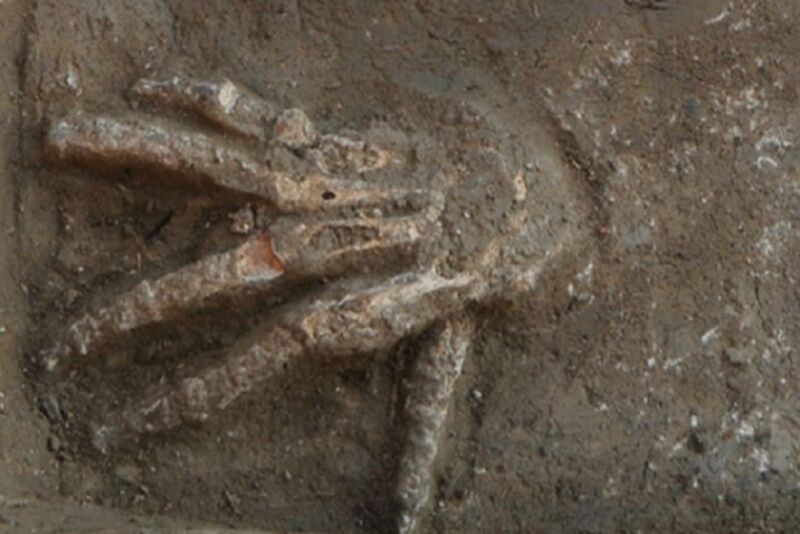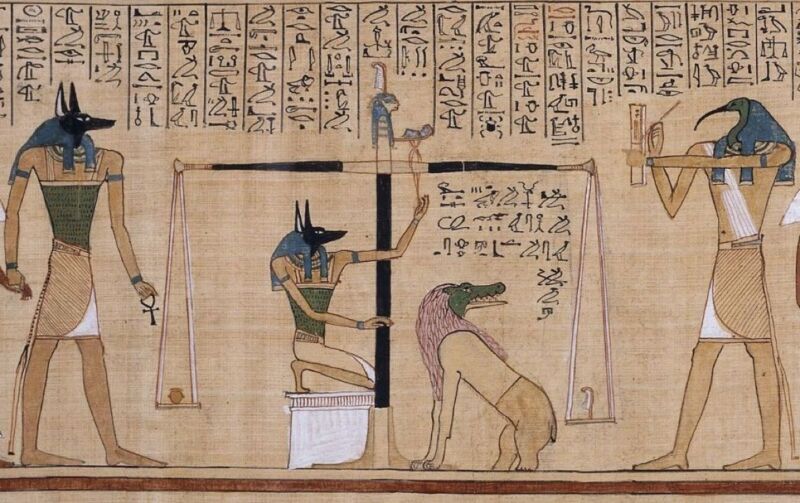
Enlarge / Archaeologists have discovered the first physical evidence of the so-called "gold of honor" ceremony in Ancient Egypt, in which the severed hands of defeated foes were presented to the Pharaoh in exchange for a collar of golden beads. (credit: J. Gresky et al., 2023/CC BY 4.0)
There is evidence that ancient Egyptian soldiers would sever the right hands of foes and present them to the Pharaoh. That evidence comes in the form of tomb inscriptions of prominent warriors, as well as inscriptions and iconography on temple reliefs. Archaeologists have now discovered the first physical evidence of such a trophy-taking practice, according to a recent paper published in the journal Scientific Reports. The severed right hands of 12 individuals were excavated from pits within a courtyard of a 15th Dynasty palace in northeastern Egypt.
The 15th Dynasty (circa 1640-1530 BCE) rulers were known as Hyksos ("rulers of foreign lands"), although they did not control all of Egypt from their seat of power in the city of Avaris—the pharaohs of the 16th and 17th Dynasties ruled from Thebes during the same time period. Historians disagree about whether the Hyksos came to Egypt as invaders or gradually settled in the Nile Delta before rising to power. But by the late 17th Dynasty, the Hyksos and the pharaohs were at war, leading to the former's defeat by Ahmose I, who founded the 18th Dynasty.
But the Hyksos nonetheless left their mark on Egyptian culture in the form of certain technological advances and customs, including the practice of presenting the severed right hands of defeated foes in a so-called "gold of honor" ceremony in exchange for a collar of golden beads. Per the authors, the Egyptians seem to have adopted the custom during Ahmose I's reign at the latest, based on a relief showing a pile of hands in his temple in Abydos. Tomb inscriptions and temple reliefs from the 18th to the 20th Dynasties "consistently depict hand counts on the battlefield following major battles," the authors wrote. However, there was no physical evidence of the custom beyond iconographic and literary sources—until now.
Guest post by Killian Clarke
Counterrevolutions have historically received much less attention than revolutions, but the last decade has shown that counterrevolutions remain a powerful—and insidious—force in the world.
In 2013, Egypt’s revolutionary experiment was cut short by a popular counterrevolutionary coup, which elevated General Abdel Fattah el-Sisi to the presidency. In neighboring Sudan, a democratic revolution that had swept aside incumbent autocrat Omar al-Bashir in 2019 was similarly rolled back by a military counterrevolution in October 2021. Only three months later, soldiers in Burkina Faso ousted the civilian president Roch Marc Christian Kaboré, who had been elected following the 2014 Burkinabè uprising.
These counterrevolutions all have something in common: they all occurred in the aftermath of unarmed revolutions, in which masses of ordinary citizens used largely nonviolent tactics like protests, marches, and strikes to force a dictator from power. These similarities, it turns out, are telling.
In a recent article, I show that counterrevolutionary restorations—the return of the old regime following a successful revolution—are much more likely following unarmed revolutions than those involving armed guerilla war. Indeed, the vast majority of successful counterrevolutions in the 20th and 21st centuries have occurred following democratic uprisings like Egypt’s, Sudan’s, and Burkina Faso’s.
Why are these unarmed revolutions so vulnerable? After all, violent armed revolutions are usually deeply threatening to old regime interests, giving counterrevolutionaries plenty of motivation to try to claw back power. There are at least two possible explanations.
The first is that, even though counterrevolutionaries may be desperate to return, violent revolutions usually destroy their capacity to do so. They grind down their armies through prolonged guerilla war, whereas unarmed revolutions leave these armies largely unscathed. In the three cases above, there was minimal security reform following the ousting of the incumbent, forcing civilian revolutionaries to rule in the shadow of a powerful old regime military establishment.
A second explanation focuses on the coercive resources available to revolutionaries. During revolutions waged through insurgency or guerilla war, challengers build up powerful revolutionary armies, like Fidel Castro’s Rebel Army in Cuba or Mao’s Red Army in China. When these revolutionaries seize power, their armies serve as strong bulwarks against counterrevolutionary attacks. The Bay of Pigs invasion in Cuba is a good example: even though that campaign had the backing of the CIA, it quickly ran aground in the face of Castro’s well-fortified revolutionary defenses. In contrast, unarmed revolutionaries rarely build up these types of coercive organizations, leaving them with little means to fend off counterrevolutions.
After looking at the data, I found that the second explanation has more weight than the first one. I break counterrevolution down into two parts— whether a counterrevolution is launched, and then whether it succeeds—and find that armed revolutions significantly lower the likelihood of counterrevolutionary success, but not counterrevolutionary challenges. In other words, reactionaries are just as likely to attempt a restoration following both armed and unarmed revolutions. But they are far less likely to succeed against the armed revolutions, whose loyal cadres can be reliably called up to defend the revolution’s gains.
Unarmed revolutions are increasing around the world, especially in regions like Latin America, Eastern Europe, the Middle East, and sub-Saharan Africa. At the same time, violent revolutions are declining in frequency, particularly those involving long, grueling campaigns that seek transformational impacts on state and society, what some call social revolutions. In one sense, these should be welcome trends, since unarmed revolutions result in far less destruction and have a record of producing more liberal orders. But given their susceptibility to reversal, should we be concerned that we are actually at the threshold of a new era of counterrevolution?
There are certainly reasons for worry. Counterrevolutions are rare events (by my count, there have only been about 25 since 1900), and the fact that there have been so many in recent years does not augur well. Counterrevolutionaries’ prospects have also been bolstered by changes in the international system, with rising powers like Russia, Saudi Arabia, and the United Arab Emirates acting as enthusiastic champions of counterrevolution, particularly against democratic revolutions in their near-abroads. Today’s unarmed revolutions, already facing uphill battles in establishing their rule, with fractious coalitions and a lack of coercive resources, must now also contend with counterrevolutionary forces drawing support from a muscular set of foreign allies.
But though they may struggle to consolidate their gains, unarmed revolutions have a record of establishing more open and democratic regimes than armed ones do. Violent revolutions too often simply replace one form of tyranny with another. The question, then, is how to bolster these fledgling revolutionary democracies and help them to fend off the shadowy forces of counterrevolution.
International support can be crucial. Strong backing from the international community can deter counterrevolutionaries and help new regimes fend off threats. Ultimately, though, much comes down to the actions of revolutionaries themselves—and whether they can keep their coalitions rallied behind the revolutionary cause. Where they can, they are typically able to defeat even powerful counterrevolutions, by relying on the very same tactics of people power and mass protest that brought them success during the revolution itself.
Killian Clarke is an assistant professor at Georgetown University.

Enlarge / Map of the known corridors and rooms inside the Great Pyramid of Giza. Evidence of a secret corridor was detected in 2016 behind the famed chevron blocks on the north face (h). Another mysterious large void (i) was discovered in 2017—a possible hidden chamber. (credit: Procureur et al., 2023)
In 2016, scientists using muon imaging picked up signals indicating a hidden corridor behind the famous chevron blocks on the north face of the Great Pyramid of Giza in Egypt. The following year, the same team detected a mysterious void in another area of the pyramid, believing it could be a hidden chamber. Two independent teams of researchers, using two different muon imaging methods, have now successfully mapped out the corridor for the first time, according to a new paper published in the journal Nature Communications. Zahi Hawass, Egypt’s former antiquities minister, called it "the most important discovery of the 21st century."
As we've reported previously, there is a long history of using muons to image archaeological structures, a process made easier because cosmic rays provide a steady supply of these particles. An engineer named E.P. George used them to make measurements of an Australian tunnel in the 1950s. But Nobel-prize-winning physicist Luis Alvarez really put muon imaging on the map when he teamed up with Egyptian archaeologists to use the technique to search for hidden chambers in the Pyramid of Khafre at Giza. Although it worked in principle, they didn't find any hidden chambers.
There are many variations of muon imaging, but they all typically involve gas-filled chambers. As muons zip through the gas, they collide with the gas particles and emit a telltale flash of light, which is recorded by the detector, allowing scientists to calculate the particle's energy and trajectory. It's similar to X-ray imaging or ground-penetrating radar, except with naturally occurring high-energy muons rather than X-rays or radio waves. That higher energy makes it possible to image thick, dense substances like the stones used to build pyramids. The denser the imaged object, the more muons are blocked, casting a telltale shadow. Hidden chambers in a pyramid would show up in the final image because they blocked fewer particles.

Enlarge / Sample illustration from an Egyptian Book of the Dead—not the newly discovered papyrus—depicting the "weighing of the heart." (credit: Public domain)
Archaeologists have confirmed that a papyrus scroll discovered at the Saqquara necropolis site near Cairo last year does indeed contain texts from the Egyptian Book of the Dead—the first time a complete papyrus has been found in a century, according to Mostafa Waziri, secretary-general of the Supreme Council of Antiquities in Egypt. The scroll has been dubbed the "Waziri papyrus." It is currently being translated into Arabic.
Fans of the 1999 film The Mummy know that the Egyptian Book of the Dead plays a key role in bringing the cursed high priest Imhotep back to terrorize the living. The reality is naturally quite different: notably, there is not one magical copy of the Book of the Dead, as depicted in the film; there were many versions over the centuries, all unique, with the choice of spells often tailored to the specific needs of deceased royals and (later) high-ranking members of Egyptian society.
These "books" were actually collections of funerary texts and spells to help the deceased on their journey through the underworld (Duat)—not to bring people back from the dead—and they are not holy texts like the Bible or Qur-an. They were originally painted onto objects or written on the walls of burial chambers. Over time, illustrations were added and spells were also inscribed on the interior of coffins or the linen shrouds used to wrap the deceased.